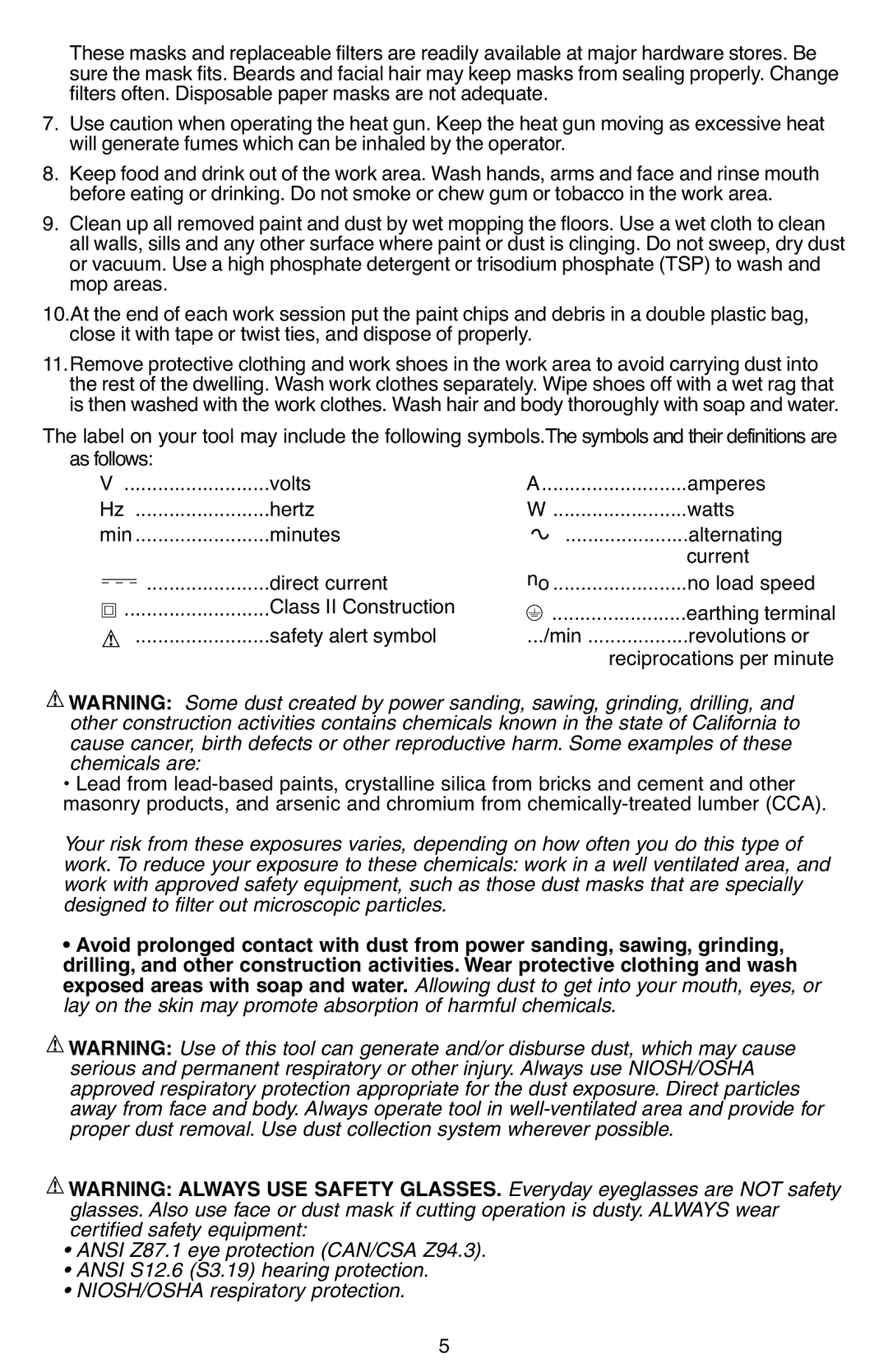
These masks and replaceable filters are readily available at major hardware stores. Be | |||||||
sure the mask fits. Beards and facial hair may keep masks from sealing properly.Change | |||||||
filters often. Disposable paper masks are not adequate. |
| ||||||
7. Use caution when operating the heat gun. Keep the heat gun moving as excessive heat | |||||||
will generate fumes which can be inhaled by the operator. |
| ||||||
8. Keep food and drink out of the work area. Wash hands, arms and face and rinse mouth | |||||||
before eating or drinking. Do not smoke or chew gum or tobacco in the work area. | |||||||
9. Clean up all removed paint and dust by wet mopping the floors. Use a wet cloth to clean | |||||||
all walls, sills and any other surface where paint or dust is clinging. Do not sweep, dry dust | |||||||
or vacuum. Use a high phosphate detergent or trisodium phosphate (TSP) to wash and | |||||||
mop areas. |
|
|
|
|
| ||
10.At the end of each work session put the paint chips and debris in a double plastic bag, | |||||||
close it with tape or twist ties, and dispose of properly. |
| ||||||
11.Remove protective clothing and work shoes in the work area to avoid carrying dust into | |||||||
the rest of the dwelling. Wash work clothes separately.Wipe shoes off with a wet rag that | |||||||
is then washed with the work clothes. Washhair and body thoroughlywith soap and water. | |||||||
The label on your tool may include the following symbols.Thesymbolsand their definitionsare | |||||||
as follows: | volts | A | amperes | ||||
V | |||||||
Hz | hertz | W | watts | ||||
min | minutes |
|
| ...................... | alternating | ||
|
|
|
| no | current | ||
|
| ...................... | direct current | no load speed | |||
|
|
| |||||
| .......................... | Class II Construction |
|
| ........................ | earthing terminal | |
|
|
| .../min | ||||
| ........................ | safety alert symbol | revolutions or | ||||
|
|
|
|
|
|
| reciprocations per minute |
![]() WARNING: Some dust created by power sanding, sawing, grinding, drilling, and other construction activities contains chemicals known in the state of California to
WARNING: Some dust created by power sanding, sawing, grinding, drilling, and other construction activities contains chemicals known in the state of California to
cause cancer, birth defects or other reproductive harm. Some examples of these
Your risk from these exposures varies, depending on how often you do this type of work. To reduce your exposure to these chemicals: work in a well ventilated area, and work with approved safety equipment, such as those dust masks that are specially designed to filter out microscopic particles.
•Avoid prolonged contact with dust from power sanding, sawing, grinding, drilling, and other construction activities. Wear protective clothing and wash exposed areas with soap and water. Allowing dust to get into your mouth, eyes, or lay on the skin may promote absorption of harmful chemicals.
![]() WARNING: Use of this tool can generate and/or disburse dust, which may cause serious and permanent respiratory or other injury. Always use NIOSH/OSHA approved respiratory protection appropriate for the dust exposure. Direct particles away from face and body. Always operate tool in
WARNING: Use of this tool can generate and/or disburse dust, which may cause serious and permanent respiratory or other injury. Always use NIOSH/OSHA approved respiratory protection appropriate for the dust exposure. Direct particles away from face and body. Always operate tool in
![]() WARNING: ALWAYSUSE SAFETY GLASSES. Everyday eyeglasses are NOT safety glasses. Also use face or dust mask if cutting operation is dusty. ALWAYSwear certified safety equipment:
WARNING: ALWAYSUSE SAFETY GLASSES. Everyday eyeglasses are NOT safety glasses. Also use face or dust mask if cutting operation is dusty. ALWAYSwear certified safety equipment:
•ANSI Z87.1 eye protection (CAN/CSA Z94.3).
•ANSI S12.6 (S3.19) hearing protection.
•NIOSH/OSHA respiratory protection.
5
